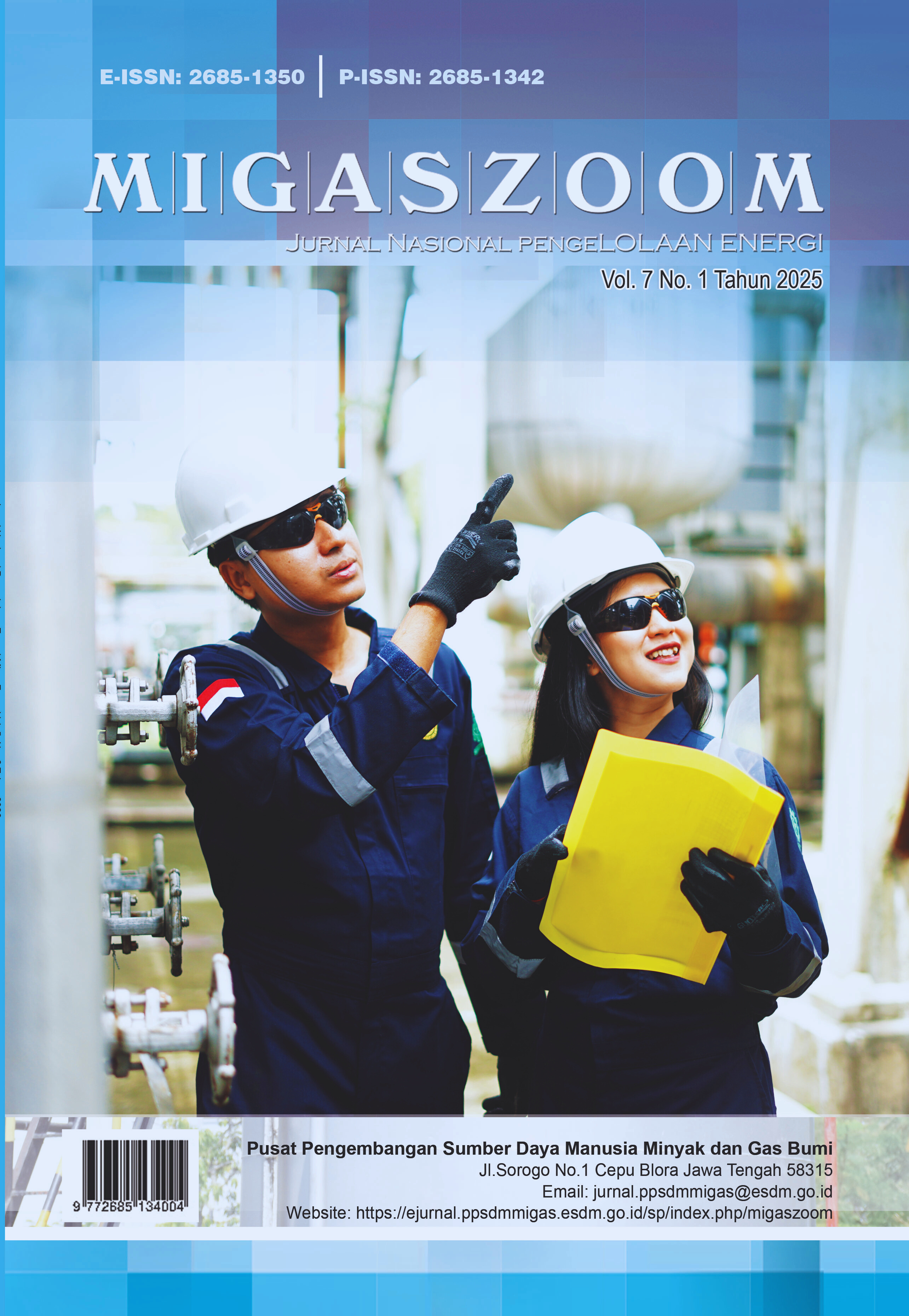Pengaruh Penambahan Polyacrylamide (PAM) Terhadap pH, Total Dissolved Solid, dan Kekeruhan dengan Metode Jar Test pada Water Treatment Plant
DOI:
https://doi.org/10.37525/mz/2025-1/646Keywords:
Jar Test, Kekeruhan, Polyacrylamide, pH, TDSAbstract
Air berperan penting karena sifatnya yang fundamental sehingga sebagian besar makhluk hidup memerlukan air untuk memenuhi kebutuhan seperti kebersihan dan konsumsi. Pada industri minyak dan gas bumi yang memiliki kilang, air dimanfaatkan untuk sebagai makeup water. Penelitian ini bertujuan untuk mengetahui pengaruh penambahan polyacrylamide (PAM) pada pH, Total Dissolved Solid (TDS), dan kekeruhan Water Treatment Plant di PPSDM Migas Cepu. Pada penelitian ini digunakan metode Jar Test dengan memiliki tiga tahapan dalam prosesnya, yang pertama proses koagulasi, tahap selanjutnya yaitu proses flokulasi dan tahap ketiga adalah proses sedimentasi. Hasil pH awal sebesar 6,57. Setelah penambahan PAM diperoleh hasil optimal yaitu 7,09 dengan konsentrasi 15 ml. Kemudian, hasil awal TDS sebesar 1040 µS/cm, setelah penambahan PAM diperoleh hasil optimal yaitu 1015 µS/cm dengan konsentrasi 15 ml. Dan nilai awal kekeruhan sebesar 0,76 NTU, setelah penambahan PAM diperoleh hasil optimal yaitu 2,48 NTU dengan konsentrasi 25 ml.
References
Adrian, V. (1998). “Principles of Chemical Microsensors,” Lect. Notes Delft Univ. Technol.
Afrianita, R., Edwin, T., & Alawiyah, A. (2017). “Analisis Intrusi Air Laut dengan Pengukuran Total Dissolved Solids (TDS) Air Sumur Gali di Kecamatan Padang Utara”. Jurnal Teknik Lingkungan UNAND, 14(1): 62-72.
Aneta, R., Umboh, J. M. L., & Sondakh, R. C. (2021). “Analisis Tingkat Kekeruhan, Total Dissolved Solids (TDS) dan Kandungan Escherichia coli pada Air Sumur di Desa Arakan Kecamatan Tatapaan”. Jurnal KESMAS, 10 (4): 106-111
Artiningrum, T., & Feliceldi, M. (2023). “Effectiveness of Poly Aluminum Chloride Coagulant on The Performance of IPAM Badaksinga, Bandung City”. Journal of Universal Studies, 3(1): 181-190.
Athena, Z., Afni, A. N., & Sukri, B. I. (2020). “Pengaruh Pemberian Polyacrylamide (Pam) Terhadap Laju Erosi Pada Bedengan Yang Diukur Dengan Metode Geodetik Dan Beberapa Sifat Fisik Tanah Di Tanah Ultisol”. Journal Of Tropical Upland Resources, 2(02) : 251–258.
Aziz, T., Pratiwi, D. Y., & Rethiana, L. (2013). “Pengaruh penambahan tawas Al2 (SO4) 3 dan kaporit Ca (OCl) 2 terhadap karakteristik fisik dan kimia air sungai lambidaro”. Jurnal Teknik Kimia, 19(3), 55-65.
Bharti, S. (2019). “A critical review on flocculants and flocculation”. Non-Metallic Material Science, 1(1): 11-21. https://doi.org/10.30564/omms.v1i1.645
Darmana, T., Qosim, M. N., Hidayat, S., & Ariman. (2022). “Sistem Deteksi Kejernihan Air dengan Menggunakan LoRa”. Prosiding Seminar Nasional Energi, Kelistrikan, Teknik Dan Informatika, 3
Dhamayanthie, I., & Fauzi, A. (2017). “Pengaruh Bakteri pada Bak Aerasi di Unit Waste Water Treatment”. Jurnal Ilmiah Indonesia, 2(3): 40-49.
Ekoputri, S. F., Rahmatunnisa, A., Nulfaidah, F., Ratnasari, Y., Djaeni, M., & Sari, D. A. (2024). “Pengolahan Air Limbah dengan Metode Koagulasi Flokulasi pada Industri Kimia”. Jurnal Serambi Engineering, 9 (1) : 7781-7787.
Fisma, I. Y. , & Bhernama, B. G. (2020). “Analisis Air Limbah yang Masuk pada Waste Water Treatment Plant (WWTP)”. Ar- Raniry Chemistry Journal, 2(2): 50-58. https://doi.org/10.22373/amina.v2i2.496
Gafur, A., Kartini, A. D., & Rahman. (2016). “Studi Kualitas Fisik Kimia dan Biologis pada Air Minum Dalam Kemasan Berbagai Merek yang Beredar di Kota Makassar”. Jurnal Higiene, 3(1):37–46.
Ghony, M. A., Jessika, & Hariyadi, A. (2024). “The Effect of Using Chemical Poly Aluminum Chloride (PAC) and Polyacrylamide (PAM) on the Water Purification Process in Purifiers in PLTU Tanjung Enim PT. BEST 3 x 10 MW”. Jurnal Ilmiah Teknik dan Sains, 3(1): 147-153.
Hamidah, W., & Cindramawa, C. (2020). “Analysis of pH, Total Dissolved Solid (TDS), and Mn levels in Well Water in Cirebon Regency”. Indonesian Journal of Chemical Research, 5(1): 8-15. https://doi.org/10.20885/ijcr.vol5.iss1.art2
Husaini, Cahyono, S. S., Suganal, & Hidayat, K. N. (2018). “Comparison of Experimental and Commercial Coagulants Using Jar Test Method”. Jurnal Teknologi Mineral dan Batubara, 14(1): 31-45.
Imamudin, M. (2012). “Peranan Air Dalam Perspektif Al-Quran (Air Sebagai Sumber Kehidupan)”. El-Hayah: Jurnal Biologi, 3(1).
Khofifah., & Utami, M. (2022). “Analisis kadar Total Dissolved Solid (TDS) dan Total Suspended Solid (TSS) Pada Limbah Cair dari Industri Gula Tebu”. Indonesian Journal of Chemical Research, 7 (10) : 43 - 49. e-ISSN:2614-5081
Kusniawati, E., Nuryanti, R., & Walici, A. S. (2023). “Utilization of Papaya Seeds (Carica papaya L.) as Biocoagulants to Improve the Quality of Well Using Parameters of pH, TSS, TDS, and Turbidity”. Jurnal Cakrawala Ilmiah, 2(5): 2177-2184.
Kusuma, P. T., & Hadiwidodo. (2017). “Menggunakan Kitosan Dari Limbah Cangkang Keong Sawah (Pila Ampullacea) Sebagai Nano Biokoagulan Dalam Pengolahan Limbah Cair Pt . Phapros , Tbk Semarang” 6 (1) : 1-7.
Mayasari, R., Hastarina, M., & Apriyani, E. (2019). “Analisis Turbidity Terhadap Dosis Koagulan dengan Metode Regresi Linear”. Jurnal Integrasi Sistem Industri, 6(2): 118-125.
Nisa, N. I. F., & Aminudin, A. (2019). “Pengaruh Penambahan Dosis Koagulan Terhadap Parameter Kualitas Air dengan Metode Jar Test”. Jurnal Riset Sains dan Teknologi, 3 (2).
Nur, M. F. M., Putra, N. H., & Ningsih, E. (2020). “Kombinasi Koagulan dan Flokulan dalam Pengolahan Air Limbah Industri Farmasi”. Seminar Nasional Sains dan Teknologi Terapan VIII, 1(1): 339-344.
Omar, A. F., & MatJafri, M.Z. (2009). “Turbidimeter Design and Analysis: A Review on Optical Fiber Sensors for the Measurement of Water Turbidity,” Sensors, 9 (10) : 8311–8335.
Pemerintah Republik Indonesia. (2021). Peraturan Pemerintah Republik Indonesia Nomor 22 Tahun 2021 Tentang Penyelenggaraan Perlindungan dan Pengelolaan Lingkungan Hidup. Jakarta: Pemerintah Republik Indonesia.
Pratiwi, I., & Setiorini, I. A. (2023). “Penurunan Nilai pH, COD, TDS, TSS pada Air Sungai Menggunakan Limbah Kulit Jagung Melalui Adsorben”. Jurnal Redoks, 8(1): 55-62. https://doi.org/10.31851/redoks.v8i1.10830
Puspitarini, R., & Ismawati, R. (2023). “Monitoring Total Dissolved Solid (TDS), Konduktivitas dan pH pada Air Lindi dan Air Sumur TPA Pasuruhan Kabupaten Magelang”. Jurnal Inovasi Teknik Kimia, 8(4): 279-286.
Sari, N. R., Putra, S. A., Abrar, A. (2023). “Analisis Intrusi Air Laut Dengan Pengukuran Total Dissolved Solid (TDS) dan Turbidity Air Sumur Gali di Kecamatan Dumai Selatan”. Jurnal SLUMP TeS, 1 (2) : 91-100. e-ISSN : 2963-1726
Sa’diyah, K., Syarwani, M., & Udjiana, S. S. (2018). “Pengolahan Air Limbah Domestik Menggunakan Kombinasi Settlement Tank dan Fixed-Bed Coloumn Up-Flow”. Jurnal Teknik Kimia dan Lingkungan, 2(2): 84-88. 10.33795/jtkl.v2i2.72
Sutoyo, S. (2019). “Pengaruh Penambahan Koagulan Tawas Al2 (SO4) 3 terhadap Tingkat Kekeruhan Sumber Air Baku di PDAM Tirta Keumueneng Kota Langsa Aceh”. QUIMICA: Jurnal Kimia Sains dan Terapan, 1(1), 25-29.
Syauqiah, I., Wiyono, N., & Faturrahman, A. (2017). “Sistem Pengolahan Air Minum Sederhana (Portable Water Treatment)”. Konversi, 6(1): 28-36. http://dx.doi.org/10.20527/k.v6i1.4777
Tim IT PPSDM Migas. (2024). PPSDM Migas [Halaman Web]. Diakses dari https://ppsdmmigas.esdm.go.id/id/Landing/index
Veber, E. V., Yulistio, N., Fitriyah, Q., & Wahyudi, P. E. (2021). “Water Treatment”. Journal of Applied Sciences, Electrical Engineering and Computer Technology, 2(1): 31-37. https://doi.org/10.30871/aseect.v2i1.2933
Wahyudin, H. K. (2022). “Optimalisasi Dosis Aluminium Sulfat dalam Metode Jar Test pada IPA di PDAM Tirta Prabujaya Kota Prabumulih”. Jurnal Kolaboratif Sains, 5(12): 834-838.
Xiong, B., Loss, R. D., Shields, D., Pawlik, T., Hochreiter, R., Zydney, A., & Kumar, M. (2018). “Polyacrylamdide Degradation and Its Implications in Environmental System”. Clean Water Nature, 1 : 17
Zheng, H., Ma, J., Ji, F., Tang, X., Chen, W., Zhu, J., Liao, Y., Tan, M. (2013). “Synthesis and Application of Anionic Polyacrylamide in Water Treatment”. Asian Journal of Chemistry, 25(13): 7071-7074. http://dx.doi.org/10.14233/ajchem.2013.15144
Downloads
Published
How to Cite
Issue
Section
License
Copyright (c) 2025 Shabira Hanindya Kuswanto, Aziz Ridho Fuady, Abrila Delita Putri Siswanto, Irine Yulianingsih

This work is licensed under a Creative Commons Attribution-NonCommercial-ShareAlike 4.0 International License.
Use, distribution, and adaptation of this work are permitted for non-commercial purposes, under the following conditions:
- Proper attribution must be given to the original author and source (journal), including citation of the title, author name(s), and link to the original version.
- Modifications or adaptations must be released under the same license.
- Commercial use, including republication for financial gain, is not allowed without written permission from the copyright holder.










